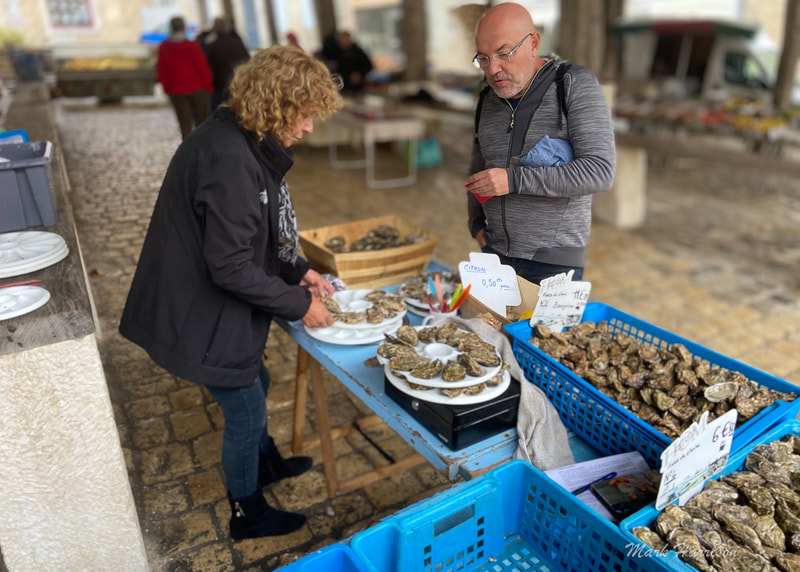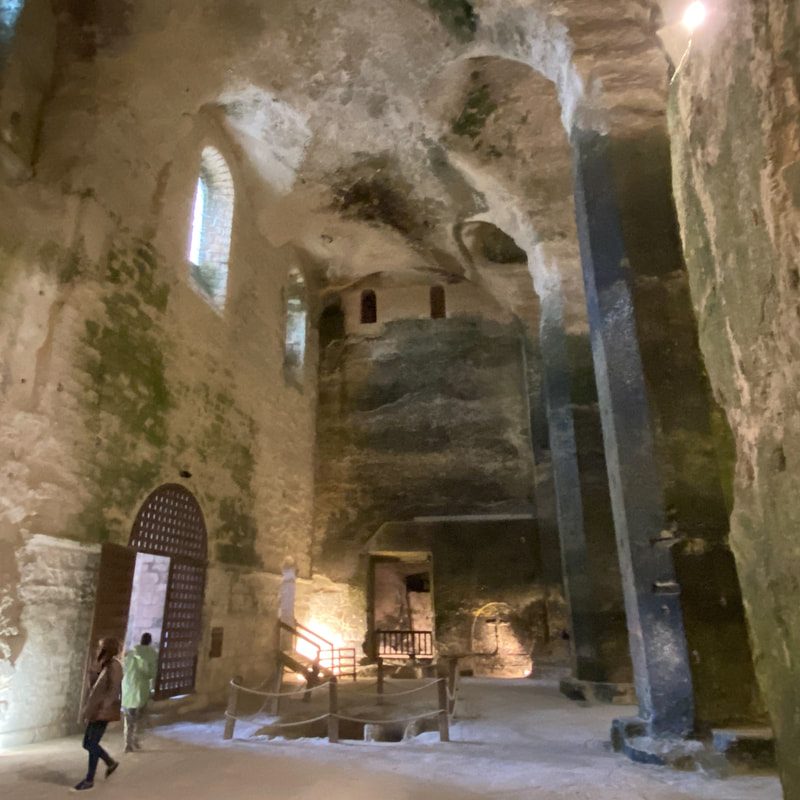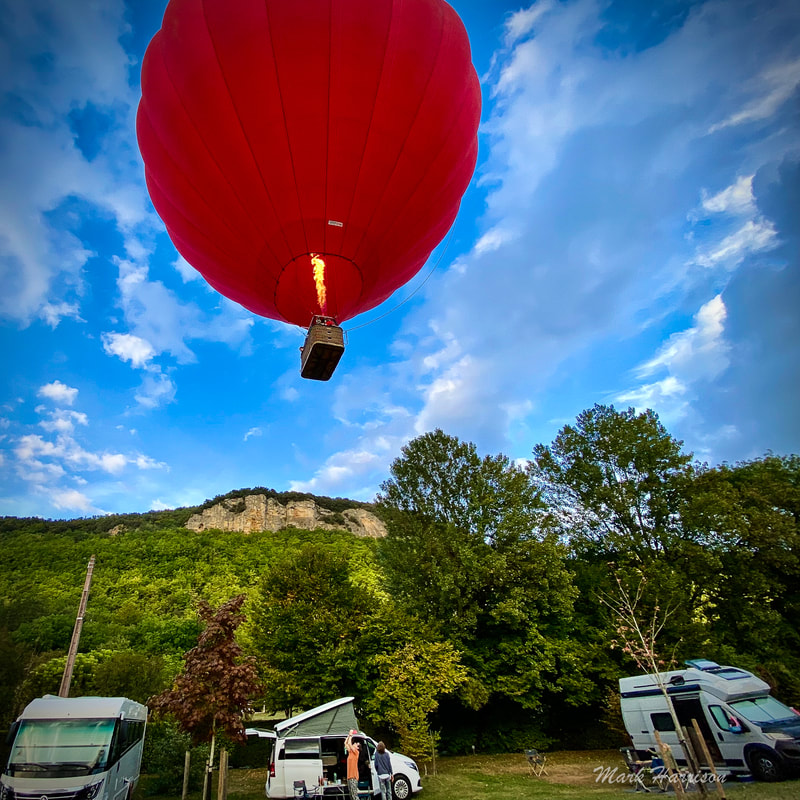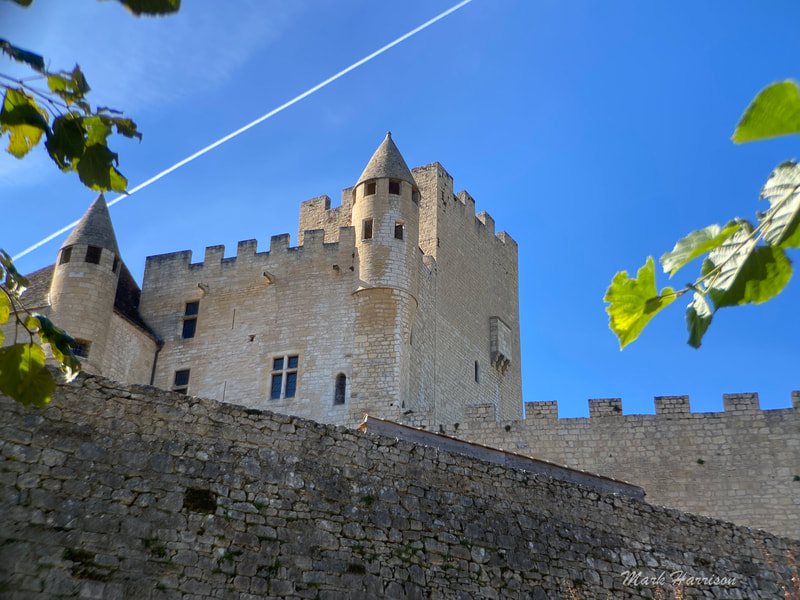|
A local expert undertaking the serious business of choosing fresh oysters for his party partaking in brunch at Villebois-Lavalette in Charente in Southern France. The department adjoins Charente-Maritime with its renowned Atlantic oyster beds. With our initial nail-biting ordeal over we succumbed to luxury for a few days, knowing full well that Sunday would arrive only too soon and we'd have to shoehorn our belongings into a camper van for the midsection of our joll. In the mean time we allowed ourselves to succumb to the incomparable impromptu delights brought by the local knowledge of friends[2]. Charente The Charente department takes its name from the eponymous river, which is the first major watercourse going North from the vast basin of tributaries feeding into the Gironde estuary, home to the port of Bordeaux. There are many attractions in Charente including Cognac, the historic town of Aubeterre-sur-Dronne, the above-mentioned Villebois and our friends (and cousins to some of us) Craig and Ann Eriksen, who were determined we would have a splendid stay in and around their new home. Aubeterre is a singularly attractive hillside town that no doubt becomes extremely busy during the French summer holidays but retained just enough of its buzz into early October when we got there. It is made up of terraces groaning with enticing places to drink and eat. It is also home to an extraordinary subterranean cathedral, which I'll come back to later. Above (clockwise from top left): terraces of Aubetterre; the town's ubiquitous (still privately owned) chateau that sits atop an extraordinary troglodyte construction (more of this later); a quick hug with the sister-in-law after a delicious pop-up-pizza. Back to brunch OK, so who (Craig and Ann excluded) has heard of Villebois-Lavalette? For that matter, who has had fresh oysters and prawns, together with a bottle of Muscadet, for brunch[3]? All consumed under the oak beams of a 17th century covered market (hall)? Actually, Shan still hasn't had the oyster bit, which meant all the more for the rest of us. I think she slightly regrets that now. Without the local knowledge and our French-speaking host it might have been a little challenging to assemble our feast. The oysters were plain to see but required Ann's French to obtain the exact size and quantity we'd be slurping for our brunch. While Ann and I were choosing our huîtres, Craig was obtaining a pile of crevettes from a pop-up vendor across the street and then putting in a request for a bottle of Muscadet from the traditional French pub opposite. This was delivered to our table in the hall with the expectation that it would be paid for at the end of our repast. Other people, who seemed to be locals, were performing a similar process at the tables surrounding ours. The selection of oysters was a particularly serious endeavour and not to be conducted in haste. For example, Ann preferred the smaller size 5 bivalve molluscs on the grounds of taste whereas old greedy guts here opted for the size 6s. If I'd known the difference at the time and been able to articulate proficiently in French, I may have questioned whether we were about to consume some of Label Rouge Marennes Oléron slippery fellas or just the common or seaweed garden Charente-Maritime variety. Happily, whatever they were that Ann chose on our behalf they were exceedingly delicious, as were the prawns washed down with Muscadet. Above (l to r): Ann positions herself to place our order; our local expert continues to build his selection; finally Ann gets to choose while another local fellow eyes her progress critically. Let the feast begin ... Above (top row, l-r): Kinks, Craig and Ann tucking in; going strong; the pub's across the road, do we need another bottle of Muscadet? (bottom row, l- r): Shan thinks we've had enough already; In the pub settling up. Troglodytes go to heaven I am always surprised when visiting France to find how many relics there are of troglodyte infrastructure. It's kind of expected in places such as Cappadocia in Turkey but not so much in France despite the fact that many troglodyte dwellings were active there at least until the 19th century. Perhaps even later according to local popular history that suggests many troglodytes were moved to state homes to save the French government the stigma of housing 20th century cavemen. Now, as is always the way, some of the cave homes, particularly in the Loire Valley, have been smartened up and occupied by artists and even the odd tourist. But that's not really what this story's about. It's about another Charente gem, the subterranean church of St. Jean. Hewn from solid rock in the 12th century, At 20m high internally, it is the largest subterranean church in Europe and, whether you're a churchy person or not, it cannot fail to take your breath away. The structure's sheer scale and the intricacy and size of its cherished artefacts can really only be viewed in situ to fully understand the undertaking, probably influenced by Christian pilgrims and, in turn, their travels through regions such as Cappadocia. When you go to visit it yourself, it is also worth knowing that the church of St Jean was hidden for centuries by a rock fall and only rediscovered in the 1950s. In the meantime the château depicted earlier in this blog was constructed on the rocky knoll above. Above (clockwise from top): It is difficult to comprehend, standing facing the cliff surmounted by the hidden château, what lies beneath - the humble portico shows there might be something but nothing gives away the splendour within; storeys high, the 20m high inner cavern in the next 3 pictures reveal the scale and attention to detail hewn out over perhaps 5 years 900 years ago; the last picture shows the crypt, set under the main edifice. The camper van beckons The time had come for us to depart from the comfort of Chez Eriksen and collect our next 12 nights' accommodation and transport from Indie Campers in Bordeaux. It would be a long day culminating at the start of a short introduction for Kinks to the Dordogne. Our VW would enjoy a well-earned rest in Saint Romain, Charente while we adopted more conventional diesel power for the next 2,000 km, taking in the Mediterranean and the Atlantic at San Sebtastián, travelling via the Pyrénées. Our first night "under canvas" took place a stone's throw from the Dordogne on the edge of Castelnaud-la-Chapelle, a handy stopping point to give Kinks a sniff of Château Beynac. The quiet campsite with its grassy meadow centrepiece was a good place to kick the tyres on our first night and to wave at a succession of hot air balloons taking advantage of a perfect late summer's evening Above: Balloon gets a hot air boost directly above us; first dop[4] in (or, more accurately outside) our home for the next 12 days. Sipping a glass of wine in the sunshine with the occasional roar of a balloon hot-air boost was probably as good a place as any to digress a bit and contemplate France and its châteaux. There are châteaux and there are châteaux. The fact that some place is named Château Finklefoggitt is no guarantee that it'll be a grand edifice. It would be stretching the imagination only a little to take you back to episode #1 of this adventure to admire Château d'En Croûton and then head off not very far South-East to Versailles and then back to Caen before dropping down to Chambord and Carcassonne to witness the diverse collection of stately homes and castles scattered across France. Basically, every town of any size at all has its château. In some places the town defines the château and in others, such as Beynac, the château defines the town. The Dordogne rivals the Loire in its diversity of châteaux and of troglodyte accommodations Castles and rivers Château Beynac dominates the small town that hugs a grand curve on the Dordogne river. We were to spend the morning there but first we needed to climb the hill. Shan and I'd done it before but it was Kinks' first Dordogne experience. This blog is not really the place to spew out the facts about the castle but you may wish to branch off for a few minutes if you want a little more info. As a tantalising taster, Château Beynac was the home of Richard the Lionheart for a bit from at the end of the 12th Century. Above (l to r): Setting off for the climb to the top; grim determination; Kinks is nearly there. Above: some perspectives of the Castle including the sweep of the plain below illustrating how strategically the fortress is placed to defend from frontal attacks. One can also gain a perspective of how it might appear from afar but become more and more intimidating the closer you get. Nowadays, of course, it is difficult to travel anywhere on mainland Europe without evidence of things flying over. Vapour trails pretty much eclipse migrating birds and this area of the Dordogne seemed particularly criss-crossed by them, perhaps because of its proximity to Toulouse. More rivers and and precious friends No road trips are ever as special as the ones that are punctuated by visits to wonderful friends. Sometimes these friends are seldom seen but the friendships are rekindled immediately. We had visited Garth and Meg Seneque in their picturesque adopted town, Saint-Antonin-Noble-Val in the Tarn-et-Garonne[5], five years earlier. Before that we hadn't seen them for decades since we had been relatively close neighbours in Durban, South Africa. The Seneques had always been academics and were still doing stuff at a serious international level in 2017 despite evidence to the contrary in the picture below: The frivolity of my unsuccessful attempt to decapitate Garth (much to the apparent amusement of Shan and Meg) went way back to the early 80s and the first time we had them around for dinner in Durban. To be honest, the two of us had been a bit intimidated by the intellectual combo we'd be entertaining that evening, something like 40 years previously. We needn't have worried. How the subject of Salvador Dali came up, none of us can remember. Probably one of us demonstrating that we knew the name of a famous artist. Someone then volunteered the information that Dali had been a great fan of farting and had, indeed, written about it in The Diary of a Genius. The evening was a success. Several books of lavatorial humour were produced and drinks were drunk. Much as they were again in October 2022. I don't think that farts were mentioned the evening we met in a local café but Meg's recent PhD was a source for congratulation and celebration. The sad news for us was that the Seneques were in the middle of packing up and moving closer to their grandchildren in Australia. They still both work in academia and related activities but on an international stage where being in the centre of things in Europe is no longer as relevant as it once might have been. Above: perhaps Garth does look a wee bit apprehensive at the prospect of me producing another carving knife but the others are clearly delighted to be reunited (Kinks was also great friends with the Seneques in the 80s). There was a tinge of sadness to our farewell that night. Australia is a long way away (although maybe, one day ... our son-in-law Andrew's Dad lives there ...) Shan's whimsical picture of night falling in Saint-Antonin with the moon highlighting the cliffs on the other side of the Aveyron river seemed to set the tone for the conclusion of this blog episode.
One thing is for sure: if you travel longitudinally through France, especially in the West, there are many grand rivers. In 24 hours we crossed the Dordogne, the Lot and the Aveyron. Tomorrow we would cross the Tarn en route to Carcassonne. Coming next
[Endnotes]:
3 Comments
Charles - Cape Town
12/11/2022 03:11:33 pm
Wow! Such wonderful travels! All sounds so amazing!
Reply
Robbie Stewart
13/11/2022 02:21:32 am
Hi Mark, Love you stories if your travels, I have gone off old structures like the church carved out of the rock, I don’t know if it applies to that particular church, but so many spectacular old structures are a symbol of the repression and slavery at the time that I can’t like that any more. I travelled to Appin where my clan originated and was surprised to see huge estate but no old village, then you hear that many of those old estates were funded through the owners involvement in the slave trade.
Reply
Leave a Reply. |
AuthorMark Harrison - making travelling an adventure Archives
April 2024
Categories |





























 RSS Feed
RSS Feed